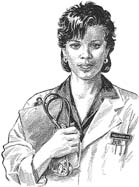History of Multiple Sclerosis 3
You've come to the History of Multiple Sclerosis 3. If you'd like to read Part 1, click here. Or go to Part 2, here.
History of Multiple Sclerosis 3
With the year 2001 in the history of multiple sclerosis, comes the McDonald criteria. This has nothing to do with eating hamburgers to cure your MS, however. Ian McDonald – there seem to be a lot of “Ian's” in the history of MS, hmmm... – put together the following set of criteria.
It helps to speed up the diagnosis even more, so that treatment can begin sooner. In the long run, doctors feel that if treatment starts sooner the progression of the disease will be much slower.
Here's the McDonald Criteria in a nutshell – well actually in a table.
McDonald Criteria Table
| Clinical Presentation | Additional Data Needed |
|---|---|
* 2 or more attacks (relapses) * 2 or more objective clinical lesions |
None; clinical evidence will suffice (additional evidence desirable but must be consistent with MS) |
* 2 or more attacks * 1 objective clinical lesion |
Dissemination in space, demonstrated by: * MRI * or a positive CSF and 2 or more MRI lesions consistent with MS * or further clinical attack involving different site |
* 1 attack * 2 or more objective clinical lesions |
Dissemination in time, demonstrated by: * MRI * or second clinical attack |
* 1 attack * 1 objective clinical lesion (monosymptomatic presentation) |
Dissemination in space demonstrated by: * MRI * or positive CSF and 2 or more MRI lesions consistent with MS and Dissemination in time demonstrated by: * MRI * or second clinical attack |
| Insidious neurological progression suggestive of MS (primary progressive MS) | One year of disease progression (retrospectively or prospectively determined) and
Two of the following: a. Positive brain MRI (nine T2 lesions or four or more T2 lesions with positive VEP) b. Positive spinal cord MRI (two focal T2 lesions) c. Positive CSF |

As you can see, the criteria is more a tool for doctors than the general population – but you can kind of get the idea. Doctors can go through the list and check off what their patient has. If it fits, then they can clearly be diagnosed with multiple sclerosis.
In 2010 the history of multiple sclerosis brings us oral medications. They join the list of other treatments for multiple sclerosis. These include laquinimod, gilenya, and natalizumab or Tysabri. This last one, stops the lymphocytes which trigger MS from ever reaching the CNS (central nervous system).
Tysabri is considered the gold standard in MS treatments today. It has come so far from the hit or miss treatment where you might develop a fatal infection of the brain called PML. Since then, doctors are able to test each patient before they begin taking the infusions to make sure their T cells aren't elevated. If they are, you can't take Tysabri.
Now, it's safe to take it as long as you continue to be tested every few months to make sure you aren't at risk for developing PML. Cir and I decided that, in the early stages, Tysabri wasn't worth the risk. With testing, it's a viable option and YES, Cir has been on Tysabri for over 3 years.
You can read his story - or history :) - while taking it here, if you like.
More Treatments for MS
It seems like every year there is a new treatment for multiple sclerosis. We'll be watching TV and a commercial will pop up touting the benefits of this or that medication for MS. I've tried keeping the MS Treatments page updated, however, I've fallen a bit behind. You can check out what's there so far as well.
There are also studies going on for therapies other than medications. I recently read an article about the Oak Clinic where Cir is treated for MS. They received the $5000 Nightingale Award which helped them set up a program called Wellness Wednesdays. The clinic encourages patients to eat a healthy plant-based diet and to also exercise along with their traditional treatments.

We're a little ahead of the game on that point since we adopted a plant-based lifestyle about a year and a half ago. We feel much better just like the patients who were interviewed in the article. Eliminating processed foods and eating more healthy will always be helpful if you have health challenges.
So jump on the bandwagon, or should I say market cart, and challenge yourself to eat less processed food, less sugar, and try more plant-based options. Who knows, it may actually help.
Ongoing history of multiple sclerosis
The history of multiple sclerosis is not yet finished. As more research is done, and more tools and technology are being developed; the cure for MS is getting nearer and nearer. We read an article recently that talked about an MS vaccine which sounds promising.
Even alternative treatments are being studied and show much promise as well. So keep the hope alive. Stay healthy so that you will be here to benefit from an MS Free world.
| History of Multiple Sclerosis - Part 1 | Part 2 | Part 3 | History of Multiple Sclerosis - Cases Part 1 | Cases Part 2 |
Dear Friends,
"Life in Spite of MS is a participant in the Amazon Services LLC Associates Program, an affiliate advertising program designed to provide a means for sites to earn advertising fees by advertising and linking to Amazon.com. We're also part of the Ebay Partner Network, another affiliate program."
We'd also like you to know it doesn't cost one cent more when you click through the links here on our blog. Not one single penny. And we will make a little extra cash when you do click through. We'll be ever so appreciative. You also have our word that we'll only link to things that we would use ourselves, (or wish we could have or use).
Sincerely,
Cir & Akrista
You are reading original content written by Akrista or Cir L'Bert of Life in Spite of MS. If you enjoyed reading this blog, please consider following us on Facebook, Twitter, Pinterest, and Instagram. See you there!
Privacy Policy ~ Advertising Policy ~ Disclaimer ~ Contact Us ~ About Us

New! Comments
Have your say about what you just read! Leave me a comment in the box below.